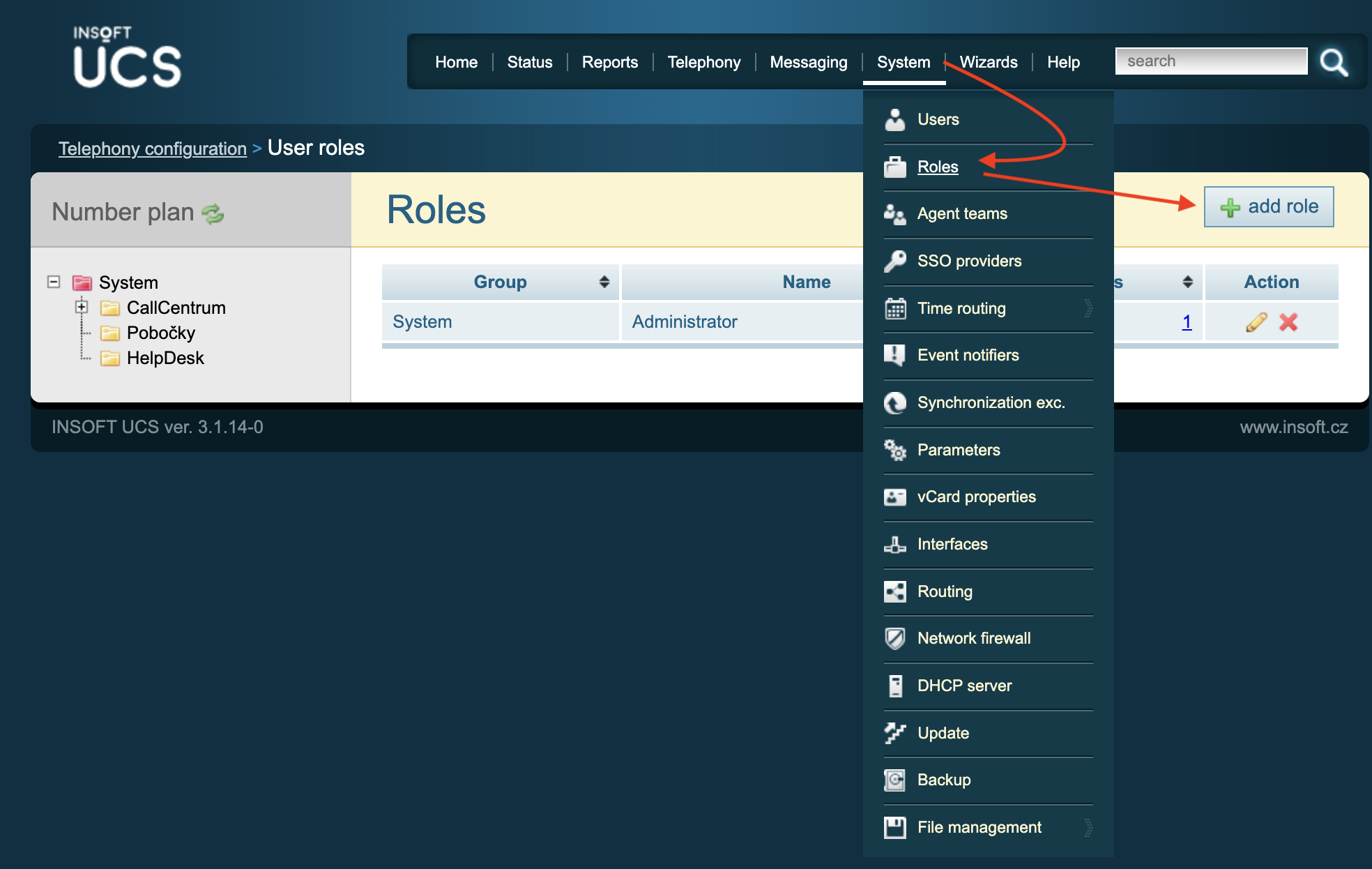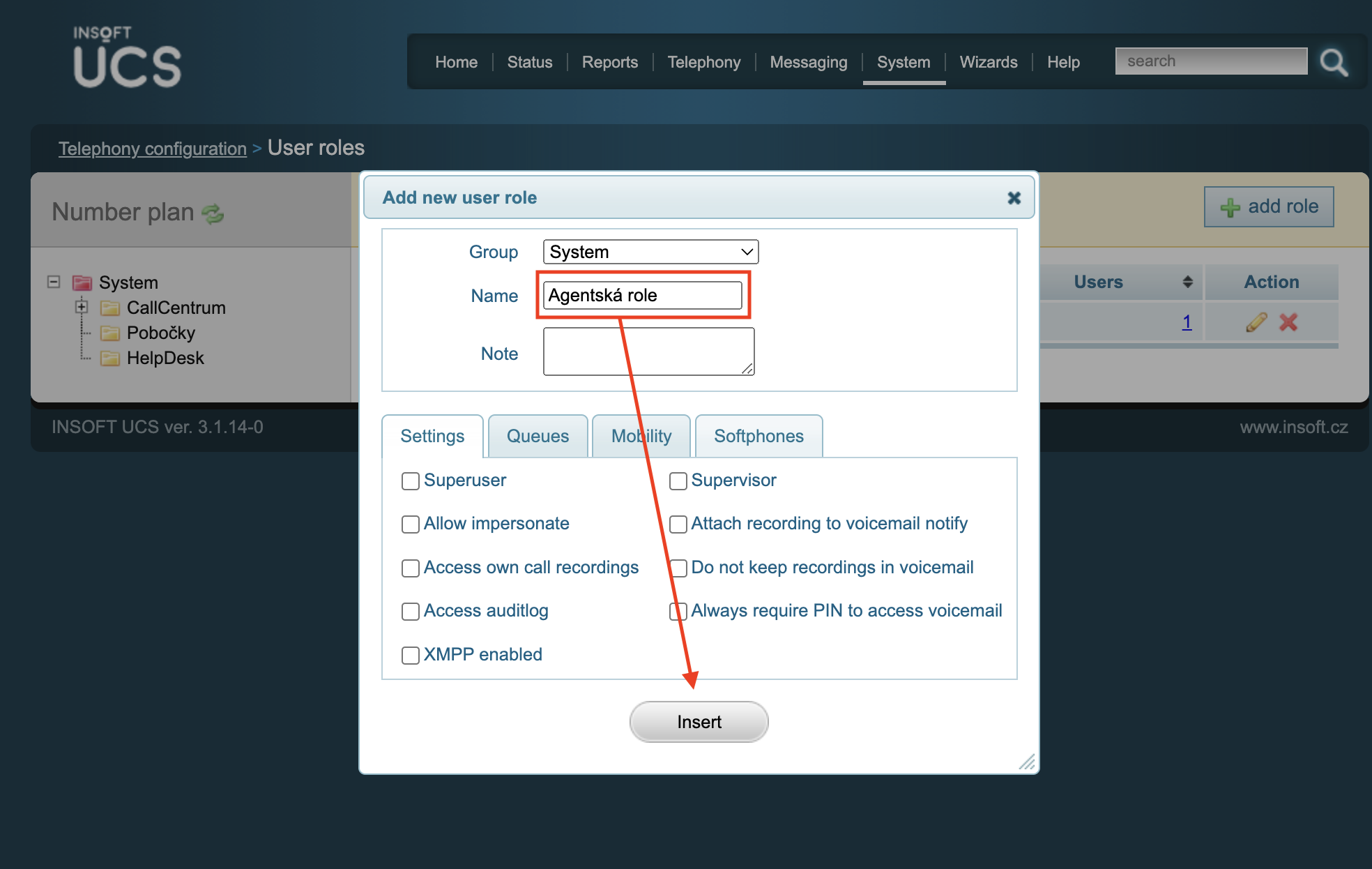User roles
- Access permissions are set for the user based on the role.
- Each user can be assigned exactly one role.
- If the user is not a member of the role, then he does not have access to any parts of the system.
When migrating to version 2.4.0, roles were automatically established according to the permissions of existing users. Roles were named after the first user having the same permission set as subsequent users who were then assigned that role.
☰ System → Roles → add role


Settings
Setting basic access rights.
| Choice | Meaning |
|---|---|
| Superuser | The user's access rights to groups are not checked and he can modify system settings (parameters and objects that are not included in groups). |
| Allow impersonate | Allows you to log in to another user. The user must have access to the group in which the user he wants to log in belongs to. A user must be a Superuser if they want to log in to another superuser. |
| Access own call recordings | Allows access to recordings of own calls without requiring the user to have ACL Billing to the appropriate group. |
| Access auditlog | Enables reading the audit log. |
| XMPP enabled | Enable the Jabber protocol for the given user. Authorization is required to use the DCom application. |
| Supervisor | Allows agents (operators) to change states |
| Attach recording to voicemail notify | Attach an audio file with a message to an informational e-mail about leaving a voice message. |
| Do not keep recordings in voicemail | Delete a voice message after sending it to email. |
| Always require PIN to access voicemail | Require the entry of the user's PIN code even when accessing the voicemail from your own IP phone. |
Queues
These are front call center parameters.
Due to the automatic role migration, these parameters have been left here for the time being. However, we assume they will be moved to the Agent Teams setting.
| Choice | Meaning |
|---|---|
| Set queue status on login | What status should be set by the user after login. The next field is the reason for not being ready (AUX reason). If automatic switch after login is activated, then the agent is also automatically switched to Offline state after logout. |
| Switch to ACW for non CC calls | Should the agent be switched to ACW state even if there is a call connected/transferred to it from outside the call center queue? The following field is the number of seconds after which the agent will automatically switch to the Ready state. |
| Synchronize presence to queue status | Synchronization of user login status (Presence) with queue status. |
| Synchronize presence from queue status | Synchronization of agent login state with user login state. This option is used for conditional forwarding to the agent's phone (Telephony → Extensions → Forwarding, forwarding in DND and Offline states). |
| Put calls to default outbound queue | Whether the agent's outbound calls should be automatically queued/outbound campaign. The first option selects the type of calls to be included (External: calls outside the switchboard, Internal: internal calls within UCS, All: all outgoing calls). The second option then determines the campaign in which the calls are to be included. If a campaign is selected that the user is not assigned to, then the selection is ignored and calls are assigned to the first outbound campaign that the user is assigned to. |
Mobility
The possibility of using the Extension Mobility functionality.
| Option | Meaning |
|---|---|
| Extension Mobility enabled | A user can log in to different phones. |
| Auto answer incoming calls to EM line | Whether to automatically receive calls that are routed to the user's line. |
| Call waiting | Allow a second call on the line (most IP phones only allow one additional call on the line, so a value of 1 is entered). |
| Set presence on login/logout | Whether the login status (Persence) should be automatically set for the user when logging in and logging out of the line (Extension Mobility). |
Softphones
Automatic provisioning of softphones to newly established users.
| Option | Meaning |
|---|---|
| Create user softphones in group | In which group should the softphones for users with this role be established. |
| Softphone extensions range beginning | The initial number of the range of assigned flaps (Extension). The number can be even higher than the end number of the range, and then the softphones are established from the higher number towards the lower one. |
| Softphone extensions range end | End number of the range of assigned dampers. If a number is already assigned within the range, then it is skipped and the next free one is assigned. |
| Softphone outgoing filter | A filter for outgoing calls that will be assigned to the newly created flap. |
ACL
It is used to set access rights to individual parts of the tree structure of the system. If a user has permission to a group, then they automatically have the same permission to everyone subgroups. If he has set an ACL for any of the subgroups, then from this one subgroups apply the newly set ACL to other subgroups.
The ACL tab appears only when editing a role.
If the user has a role with Superuser authority, then ACLs are ignored and he has access to the entire system without any restrictions.
| Authorization | Meaning |
|---|---|
| Add config | Creation of new configuration objects (e.g. doors, trunks, telephones, user accounts, etc.). |
| Edit config | Editing existing configuration objects. |
| Delete config | Disruption of existing configuration objects. |
| Monitor | Enables call interception (see Billing) and listing of agent ratings (Users → Group). |
| Control | Allows you to control the status of other agents and hang up their calls (Users → Group). |
| Billing | Access to call history. Calls are classified into two groups according to their source and destination (trunk: Trunks → Incoming pattern → Group, filter: Outgoing filters → Pattern → Group and door: Extension → Group). |
| Recording | Access to playback and download of call recordings. Access is governed by the groups to which the call belongs. |
| Recording playback | The possibility to play the recording only via IP phone or softphone. |
| Add data | Creation of new data records (e.g. numbers in blacklists, lookups, evaluation of agents, shared data, etc.). |
| Edit data | Modification of existing data records. |
| Delete data | Cancellation of existing data records. |